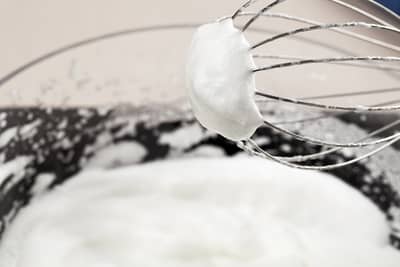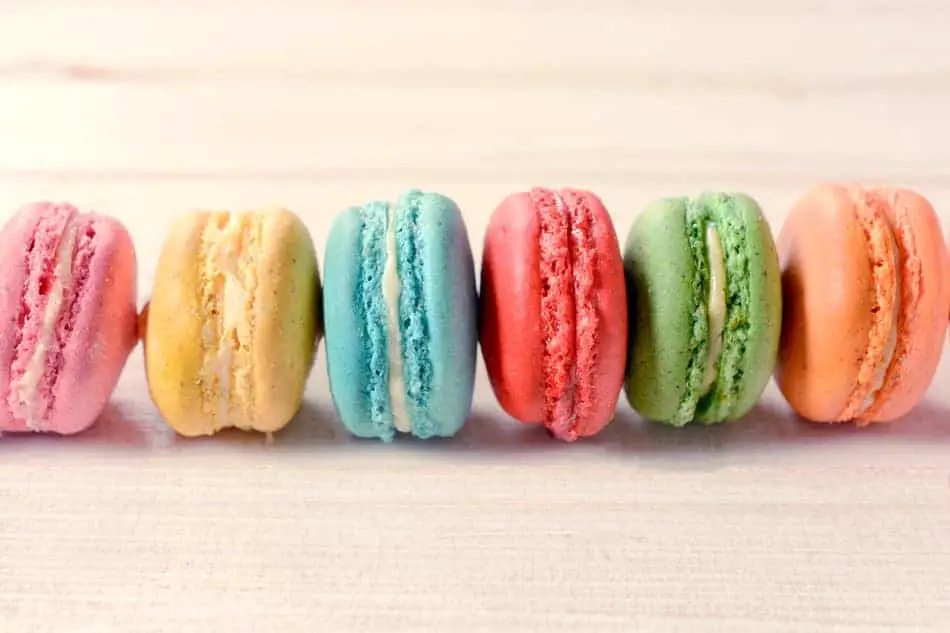Macarons and macaroons are both delicious cookies that have similar spellings but are actually completely different desserts. Questions about their vegan status often arise so we’ll address that here.
Are they vegan? Standard macarons and macaroons are never vegan. For example, the standard recipe for both calls for egg white. While there are macaroons on the market that don’t contain egg white, both contain a number of animal-derived ingredients besides egg, thus overall, neither one are vegan-friendly.1
Both cookies start with meringue as a base ingredient (more on that below), but macarons are the ones made into a sandwich with buttercream or jelly in the middle. They’re the main image above.
Macaroons are the mound-shaped cookies that are brown/crispy on the outside and chewy on the inside.
The confusion comes from the common spelling, and also because they share certain ingredients like almond meal and/or extract, coconut and egg white.
More on the definitions below.
What we’ll do here is cover the common ingredients one-by-one, their vegan-status, which cookie they’re used in, and what can be used to replace them.
Common Non-Vegan Ingredients Used in Macarons and Macaroons
Currently, I’ve yet to find any vegan macarons or macaroons on the market. But, that’s always changing and it’s only a matter of time before vegan options start to surface.
So I’m listing the ingredients here so you’ll know what to look out for when searching for a vegan version of these cookies now and in the future. And, so you’ll know what to look for if you’re browsing for recipes online.
Egg Whites (Macarons and Macaroons)

Both macarons and macaroons are meringue-based cookies.
In cooking, you have a creaming method and a meringue method which involve beating sugar into a medium—a fat like cream or butter in the former and egg in the latter.
For the meringue method, sugar is mixed in with a beaten egg (or just egg white), creating an egg foam which is folded into the batter. This method contributes volume to the mixture due to the air that’s incorporated.2
Anyway, meringue is a primary ingredient in both cookies, though I have encountered macaroons that don’t contain it.1
Aquafaba is a common vegan replacement for meringue. Aquafaba is just the juice from chickpeas. It has a high water and protein content like egg making it suitable for this application. You simply blend sugar and aquafaba with an egg beater.
Sweetened Condensed Milk (Macaroons)
This is a common ingredient in macaroons.3,4
Macaroons are meringue-based, mound-shaped cookies usually made from shredded coconut, vanilla, and almond extracts and sweetened condensed milk.5
A typical macaroon has a slightly browned and crisp exterior, with a soft and chewy interior.
Full fat coconut milk is often used as a replacement here. Just mix in sugar and evaporate some of the moisture.
Since it’s the coconut milk fat (as opposed to non-virgin coconut oil) it will have that characteristic coconut flavor. However, coconut is a standard ingredient in macaroons so this shouldn’t be a problem—it may even help!
Buttercream (Macarons)
A macaron is a sweet meringue-based cookie made with egg white, sugar (icing and granulated sugar), almond meal or almond powder, coconut, and food coloring.6,7
Most macarons are made with a buttercream sandwiched between two cookies, though jelly can be used. Like with the meringue, whipping up the butter (with sugar) into the medium (cream in this case) adds volume.
I went to a vegan restaurant a while back that had chocolate chip cookie sandwiches with a buttercream-style filling. IT WAS SPOT ON. I mean indistinguishable from buttercream.
Vegan replacements usually involve vegan butter, powdered sugar, and some sort of plant milk. Since macarons often have a coconut flavor, coconut milk is an option here.
Ganache (Macarons)
Ganache is often the outer shell of macarons. It’s a French word for a smooth, shiny, and rich chocolate cream mixture that’s used as both a filling and frosting for certain pastries and cakes.
It’s made from a heated mixture of heavy cream and chocolate that’s poured over the cookie sandwich where it hardens forming a shell.
This stuff can actually replace the buttercream if it’s whipped/creamed into what’s called a ganache beurre (fancy, I know). This consistency is obtained by whipping the basic ganache ingredients with soft butter.8
Chocolate and heavy cream are problematic ingredients here. Chocolate is an easy one because a lot of dark chocolate contains cocoa butter as the only fat. Some still contain milk additives, but many are free of these ingredients as well.
Then, there’s heavy cream. Obviously a no-go for vegans. Again, full-fat coconut milk to the rescue. Just whip it with melted chocolate and vanilla extract and you’re in business.
Other Non-Vegan Additives (Macarons and Macaroons)
So, if the above wasn’t bad enough there are a number of other non-vegan ingredients you can encounter in these food items. For example, I mentioned above that I ran across one macaroon that didn’t use egg white.
Well, to replace the egg white they had to add everything but the kitchen sink in terms of food additives to get the right consistency. So, this macaroon that would otherwise be vegan had whey in it.
Whey is a protein that’s a waste product in cheese production. (Casein is the protein manufacturers use in cheeses because it coagulates to give the right texture). Anyway, whey is used to make dietary supplements obviously but is also put into various food products as an additive.
It tends to be used in processed foods like crackers, certain types of bread, and you guessed it… commercial pastry. It’s often added to serve as a fat replacement as it provides a creamy mouthfeel in reduced-fat foods.9 It’s also used as a stabilizer, texturizer, thickener, and binder.9
Macarons often have honey incorporated into the ingredients, which isn’t vegan.
Anyway, I mention these ingredients so you’ll know that even if you find a macaron or macaroon that doesn’t have egg it may still not qualify as vegan.
Anyway, that’s it for macarons and macaroons. Thanks for reading.
References
- Macaroons. John Pearson – https://smartlabel.wakefern.com/productfood/ingredients/0041190759262-0001
- Understanding Food: Principles and Preparation (Page 111). Amy Brown – Wadsworth Cengage Learning – 2011
- “Coconut Macaroons”. Food Network. https://www.foodnetwork.com/recipes/ina-garten/coconut-macaroons-recipe4-1916076
- “Paradise Macaroons”. Food Network. https://www.foodnetwork.com/recipes/alton-brown/paradise-macaroons-recipe-2009367
- Understanding Food: Principles and Preparation (Page 491). Amy Brown – Wadsworth Cengage Learning – 2011
- “Definition of macaroon in English”. Oxford Dictionaries. https://en.oxforddictionaries.com/definition/macaroon
- “Definition of macaroon”. Merriam-Webster. https://www.merriam-webster.com/dictionary/macaroon
- Understanding Food: Principles and Preparation (Page 488). Amy Brown – Wadsworth Cengage Learning – 2011
- Understanding Food: Principles and Preparation (Page 57). Amy Brown – Wadsworth Cengage Learning – 2011

